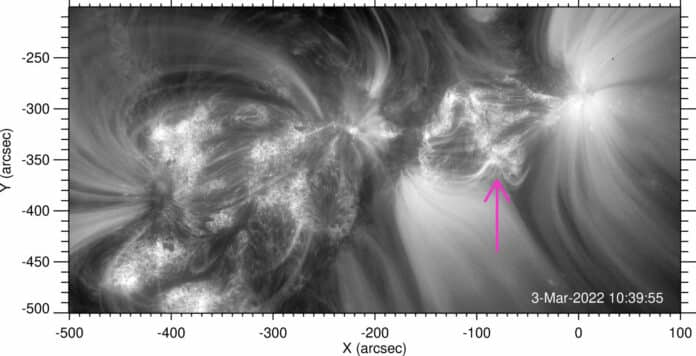Impulsive or Helium-3 enriched solar energetic particle (SEP) events, characterized by Helium-3 and ultra-heavy ion abundances, show high association with type III radio bursts. Minor (B- or C-class) GOES soft X-ray flares often accompany these events.
There are reports on such events measured in clusters from sub-flares in single active regions, where abundance showed significant variations. Imaging observations revealed that sources of these recurrent Helium-3 enriched are jets from solar plages (patches of scattered magnetic fields) or coronal hole edges.
From a distance of only half an astronomical unit (AU), or around 46.5 million miles, scientists from the Southwest Research Institute (SwRI) have made the first close-up observations of a source of energetic particles ejected from the Sun. ESA’s Solar Orbiter provided high-resolution images of the solar flare.
The Solar Orbiter, in 2022, detected six recurrent energetic ion injections. Iron levels were comparable to those of the rare isotope Helium-4, the second most abundant element on the Sun, while the intensity of the rare isotope Helium-3 exceeded that of hydrogen, the most abundant element on the Sun, in one ion injection. Two days later, Helium-3 had essentially decreased in a second injection.
Analysis revealed that the underlying photospheric field’s size, form, and distribution that changed over time are all connected to the elemental and spectral fluctuations in repeated injections.
SwRI’s Dr. Radoslav Bucik, the lead author of a new study published this month in Astronomy & Astrophysics Letters, said, “We believe that understanding the variability in recurrent events from a single source sheds light on the acceleration mechanism in solar flares.”
The Solar Orbiter’s observations are exceptional because the propagation effects that can change abundances may be negligible close to the Sun. The research team has a stunningly precise view of solar processes at a distance of just 0.5 AU.
Buick said, “When we are closer, we have a considerably better spatial resolution. We can gain more insight into the source of these energetic particles because we can see the internal structure associated with acceleration processes as the injection evolves. Observations from twice that distance, 1 AU, are unclear.”
“These observations could help predict future solar energetic particle events. These particles can damage satellites and equipment and potentially harm astronauts. We want to understand how they accelerate away from the Sun and the conditions for their acceleration.”
Journal Reference:
- R. Bučík, G. M. Mason et al. Recurrent 3He-rich solar energetic particle injections observed by Solar Orbiter at ∼0.5 au⋆. Astronomy & Astrophysics. DOI: 10.1051/0004-6361/202345875
